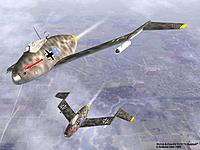History
In the late 1870s, Charles F. Ritchel (1844-1911) of Portland, Main, U.S.A. designed and built a small, one-man, hand powered dirigible.
The aircraft consisted of a tubular brass frame constructed at Folansbee Machine Shop, Bridgeport, Connecticut which hung beneath a cylindrical hydrogen filled gas bag, 12 feet in diameter and 24 feet in length made by Goodyear from rubberised black silk. The bag held 3,000 square feet of gas.
A small hand cranked propeller drove the craft that the pilot could steer using foot pedals. A "fan" was also used to provide lift allowing the craft to overcome the inherent limitations of balloons.
The aircraft could reach a height of 61m (200 ft).
Ritchel first exhibited his dirigible in Philadelphia, where he made several flights inside one of the large buildings that had been part of the Centennial Exhibition held in 1876.
The dirigible was then first demonstrated outdoors in public on June 28th, 1878 at Hartford Connecticut, Pennsylvania. The event was reported in Scientific American no less.
Subsequently, Mark Quinlan (presumably the person seen illustrated in the Posters) made most of the demonstration flights including two flights which lasted over an hour each.
Ritchel built and sold five of his "Flying-Machines".
Chas Ritchel is fully articulated; his head rotates with the Rudder, his arms respond to Ailerons and his legs (and also the propeller control block) respond to the Elevators. The hand crank turns on application of throttle. The prop spins once underway.
Derived from a
SketchUp model by ARGO Industries.
Chas derived from
The Red Baron by Max Grueter
The model can be downloaded
here.
 Views: 208
Views: 208  Views: 219
Views: 219  Views: 221
Views: 221  Views: 205
Views: 205 Views: 213
 Views: 220
Views: 220 

















